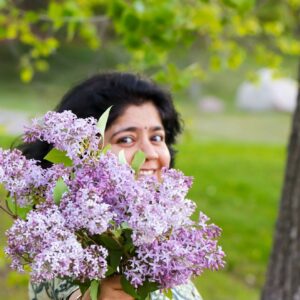by Indu Arora, 2024 SOYA Annual Retreat special guest.
Beauty is often limited and misconstrued as a combination of qualities—such as shape, color, or form—that pleases the aesthetic senses, (especially the sight) and often something that is limited to a gender or even expressions like beauty industry, products, routines, or standards. Yes, beauty means many things to many people. Yet, we can consolidate all of those varied definitions under some kind of experience.
I find it so illuminating, expansive, and relieving to understand the meaning of beauty as is shared in ancient Indian texts.

Etymology: Beauty is called saundarya in Sanskrit. The etymology points out two parts, sa and und, where und means “to be soaked/immersed in” and sa means “pleasant/positive/good”. To sum up, the word means to be soaked in the pleasantness, goodness, and positivity of the mind.
There are 4 types of Beauty/Saundarya:
Physical Beauty – Roopam: This is the beauty that radiates through healthy hair, skin, and body. Skin being the largest organ is symbolic of the state of all the tissues and internal organs. Pledge to keep your skin healthy this year!
Vibrational Beauty – Saundarya Lehar: This is the wave of beauty that radiates from a kind, compassionate, loving, caring heart.
Mental Beauty – Chitta Prasadanam: This is the beauty of the mind. My teacher used to say “Make your mind a fragrant offering, most of our minds stink.” Silence is one of the finest practices to witness the chaotic waves of the mind as well as to calm them down. There is a day dedicated to silence known as Mauni Amavasya .
Everlasting Beauty – Laya Yoga: Yogis have talked about Laya as the real Yoga, the yoga of dissolution. It is a topic kept very much limited to the oral tradition. Check out Laya Yoga of Chakras.
Let’s explore what some main texts say about beauty:
Patanjali Yoga Sutra: 1. 33
Patanjali refers to beauty as “chitta prasadanam” in Yoga Sutra 1.33. By developing the qualities of friendliness, compassion, goodwill, and indifference we can consistently maintain a peaceful/beautiful state of mind.
Saundarya Lahiri: 95
Here, beauty is described as waves of bliss, happiness, and beauty arising out of a mind that is internalized. Such a mind is pleasant and awakened in all the three states (Tripura): awake, dreaming, and deep sleep. Such a person becomes the ruler of Tripura and experiences the blessings of Tripura Sundari.
Upanishads:
Satyam Shivam Sundaram
That which is truth (satyam) and awakened (shivam) is beautiful (sundaram). Here, Shiva is referred to as Sundereshwar which means “God of beauty,” however, Shiva, here, is not a God but an awakened state of mind, consciousness itself.
There are three types of beauty discussed in Ayurveda:
Roopam: The beauty of health as radiance, immunity, and energy
Gunam: The beauty of a sattvic (pure, clear, and calm) mind
Vayastyag: The everlasting beauty of consciousness
I sincerely hope that this reading has expanded the definition of beauty for you and inspired you to seek the beauty within. For in Yoga, there are valleys of silence before there are peaks of realization. Keep practicing.
May the beauty that we see outside, awaken the beauty that we are within.

Indu Arora is a Yoga and Ayurveda teacher, mentor, and author, based out of the USA. She considers herself a student for a lifetime. Indu has been sharing about Yoga philosophy, Yoga Therapy, and Ayurveda for the last two decades. She is inspired by and taught under Kriya Yoga, Himalayan Yoga, Kashmir Shiavism, and Sivananda Yoga lineages. Indu is the special guest teacher at the South Okanagan Yoga Academy’s Annual Retreat, May 31-June 2, 2024, leading her weekend event Living Ayurveda. Learn more about the SOYA Annual Retreat here.

Recent Comments